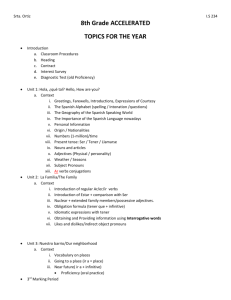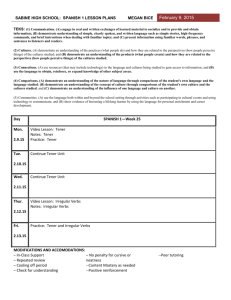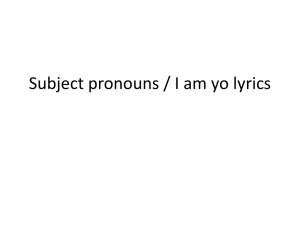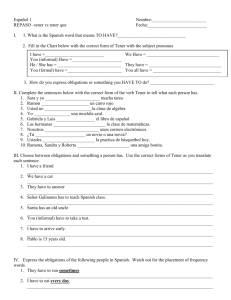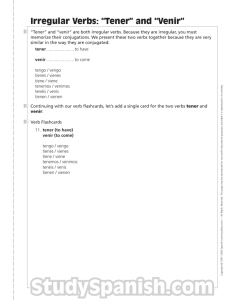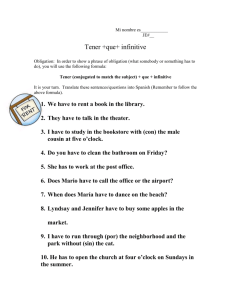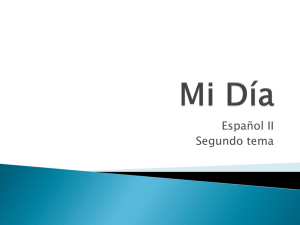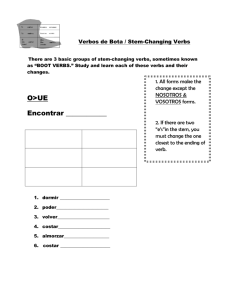VERBOS
advertisement
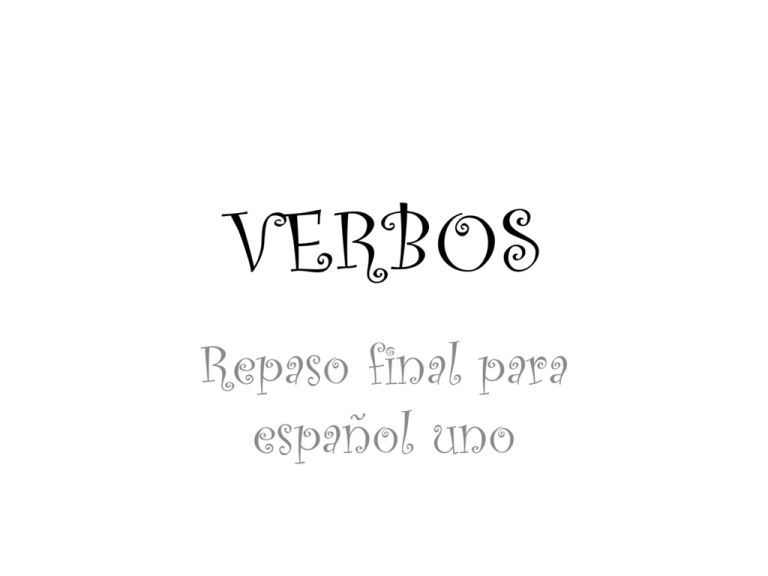
VERBOS Repaso final para español uno In Spanish 1 we have learned several different kinds of present tense verbs. • • • • Regular (–ar, -er, and –ir) Irregular (ser and ir) Stem-changing (aka Boot: u-ue, o-ue, e-ie, e-i) Stem-changing with an irregular yo form (Boots with Socks: tener and venir) • Irregular yo form Regular Verbs: To conjugate a regular verb, drop the infinitive ending (-ar, -er, or –ir) and add the ending that matches the subject to the stem, or part that is left. Singular subject -ar -er -ir Plural Subject -ar -er -ir 1. yo o o o 4. nosotros/-as _____ y yo amos emos imos 2. tú as es es 5. vosotros/-as áis éis ís 3. él/ella usted A name Singular noun a e e 6. ellos/-as ustedes Tú y _____ Usted y _____ 2+ names Plural noun an en en Irregular Verbs: Not all verbs follow the pattern we just went over. Two VERY common irregular verbs are SER (to be) and IR (to go). Sing. subject SER Plural Subject SER 1. yo soy 4. nosotros/-as somos 2. tú eres 5. vosotros/-as sois 3. él/ella usted es 6. ellos/-as ustedes son Sing. subject IR Plural Subject IR 1. yo voy 4. nosotros/-as vamos 2. tú vas 5. vosotros/-as vais 3. él/ella usted va 6. ellos/-as ustedes van Uses of IR (to go) Ir can be used to say where someone is going (ir a + place). • Yo voy a la playa. (I go to the beach.) • Nosotros vamos al parque. (We go to the park.) • Los estudiantes van al colegio. (The students go to school.) Ir can be used to talk about what someone is going to do (ir a + infinitive verb). • Yo voy a estudiar. (I am going to study.) • Tú vas a comer sushi. (You are going to eat sushi.) • Ella va a leer este fin de semana. (She is going to read this weekend.) Stem-changing or Boot verbs: These are verbs that have a spelling change in the stem (the part of the verb that is left after dropping the –ar/-er/-ir). You make the change to the stem in all the singular forms and in the third person plural form (inside the boot). You must also remember to use the correct endings to make the verb match the subject. Refer to the PP on stem-changing verbs for more info. • U-UE: jugar (to play) • O-UE: poder (to be able to), almorzar (to have lunch), dormir (to sleep), volver (to return) • E-IE: empezar (to begin), entender (to understand), merendar (to have a snack), querer (to want) • **E-I: pedir (to ask for), servir (to serve) Stem-changing with an irregular yo form or Boots with socks: TENER (to have) and VENIR (to come) are e-ie stem-changing verbs that have a different yo form. Sing. subject TENER Plural Subject TENER 1. yo tengo 4. nosotros/-as tenemos 2. tú tienes 5. vosotros/-as tenéis 3. él/ella usted tiene 6. ellos/-as ustedes tienen Sing. subject VENIR Plural Subject VENIR 1. yo vengo 4. nosotros/-as venimos 2. tú vienes 5. vosotros/-as venís 3. él/ella usted viene 6. ellos/-as ustedes vienen • • • • • • • • Uses of TENER (to have): TENER is used in the following expressions. Note that in these combinations TENER may not translate to “have”. Tener calor = to be hot Tener frío = to be cold Tener hambre = to be hungry Tener sed = to be thirsty Tener prisa = to be in a hurry Tener ___ años = to be ___ years old Tener que + infinitive verb = to have to (do something) Tener ganas de + infinitive verb = to feel like (doing something) • • • • • • • Irregular yo: There are some verbs that follow the regular verb pattern except in the first person singular (yo) form. salir (to go out or leave) – Yo salgo traer (to bring) – Yo traigo poner (to put or place) – Yo pongo hacer (to do or make) – Yo hago ver (to see or watch) – Yo veo saber (to know information) – Yo sé FOR ALL OTHER FORMS YOU TREAT THESE LIKE REGULAR VERBS AND CONJUGATE THEM ACCORDING TO THEIR ENDING (-AR/-ER/-IR)!!!
